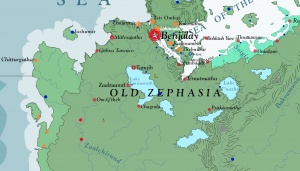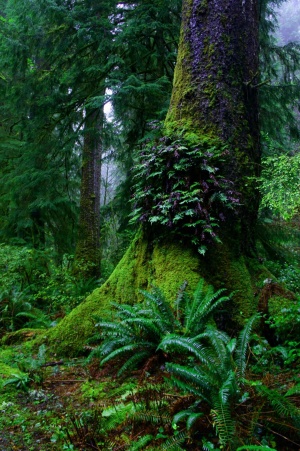Old Zephasia

Old Zephasia is the portion of Zephasia which is still governed by indigenous Zephasian tribes. It rests in northern Bahuna just south of the Isthmus of Benjalay which connects Asdauria to Bahuna. The region straddles two seas, the Blue Sea to the west and the Turtle Sea, specifically the West Turtle Sea to the east. The region reaches along the north-facing coast and ends roughly around Ishdind where the Drakeback Mountains begin along the region known as Wild Dracks. Historically, Benjalay is considered part of Old Zephasia, even though it is not part of the continent of Bahuna.
Old Zephasia is a tropical rain forest which receives roughly the same rainfall from day to day and there is no dry season.
Like much of the rest of Zephasia, the indigenous Zephasian tribes are the principal human inhabitants. They have lived in the region for well over seven thousand years according to oral tradition and archeological evidence. Some scholars believe they immigrated into Zephasia and Old Zephasia over eight thousand years ago from the Hmœss core civilization in eastern Sahimb. Native scholars generally reject this and posit a paleo-zephasian ancestor race. The oldest Zephasian legends of the region recount that they encountered the fish-men known as the Ithrabbi in the region when they first came. Today most ithrabbi live in the Turtle Sea and the frequency of encounters between humans and fish-men are kept to a minimum.
Old Zephasia was not conquered by the dagaithi tribes who invaded and subdued the northern portion of Zephasia in the middle ages, and thus is not subject to the authority of the Khamifate of Shanjahar. Benjalay is an exception. The Ishaam of Benjalay is a suzerain who offers homage to the Khamifa of Shanjahar, but holds complete internal authority over his dominion. Other city-states with princely rulers abound in Old Zephasia, such as Ishdind, Ramu-Derra, Rayootipurt, Omedzure, Thrattanzure, Prakoomatha, Zimbaddi, Temutmatha, Chagrala, Om-G'theb, Zaaltuumtl, Tamjib, Githva Tancuco, and Mithragutha. These small dominions often form alliances with Benjalay for mutual protection. The greatest threat they face is from invasion by the dracknaughts to the east and by small raids from the freshwater ithrabbi who live further south in the interior of Bahuna.
Old Zephasian religions are often seen as chaos cults by observers from the West. However, this judgment does not take into account that Old Zephasians worship many kinds of divinities, some of which are like chaos gods and some which are like the lawful Isxinthion gods. Scholars have used studies of Old Zephasian gods in order to help re-create gods and mythos of the pre-Salmakhamerian West.
There are many thousands of animals and bugs that live in Old Zephasia. The ilanx is less frequent here than in the rest of Zephasia and Sahimb. Other fauna include numerous species of venomous serpents, constrictor snakes, wild boars, army ants, giant centipedes, tigers, crocodiles, sloths, giant sloths,
Humanlikes and exotic creatures of the rain forest interior include zephasian wyverns, giant spiders, jungle trolls, uzur (gnolls), gishak, Arwine (leontaur) (rarely), lizardfolk, quirth, gargots (kobolds), dracknaughts, and ithrabbi.
The interior of Old Zephasia is home to abandoned cities and temple complexes as well as occupied settlements. Old Zephasian legends and and jungle explorers from the Pallathantic Region report having seen strange, colossal, obelisk structures deep in the interior of Old Zephasia. The provenance and purpose of these structures remains unknown. Expeditions into the jungle interior are fraught with danger due to the presence of freshwater ithrabbi, possible dracknaught colonies, and rakshasas as well as the exotic creatures previously mentioned.
See Also
| This article is a stub. It requires further development by the creator. |
